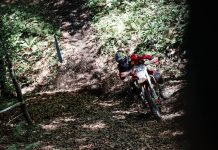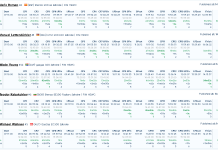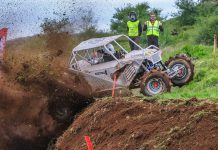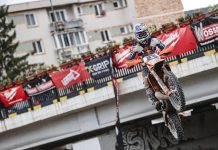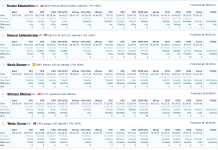![]()
RED POWER first! So zeitig war Honda schon lange nicht mehr mit seinen neuen Modellen am Start. Es geht natürlich um die 2020er Modellreihe der CRF 450R und der kleinen Schwester CRF 250R. Und es gibt einiges zu berichten, auch wenn die 450er nach ihrer letztjährigen Überarbeitung für 2020 erwartungsgemäß wenig Neuerungen mit sich bringt. Dafür krempelte man die CRF 250R entsprechend intensiv für 2020 um. Hier in kompakter Form die wichtigsten Neuerungen zum jeweiligen Modell:
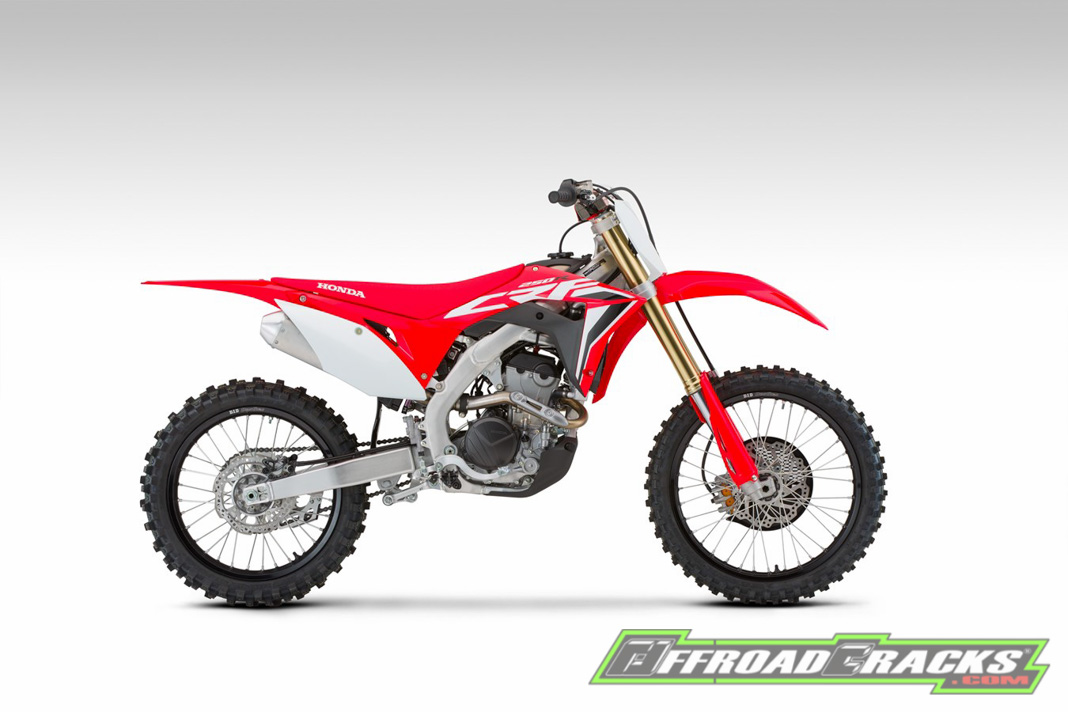
CRF 250R 2020 – NEUERUNGEN
MOTOR
- Drehmomentsteigerung im mittleren Drehzahlbereich (6.000 bis 10.000/min) um 8-10 Prozent
- Gesteigerte Spitzenleistung um vier Prozent bei 12.000/min (Drehzahllimit 14.300/min)
- Verbessertes Überdrehvermögen
- Optimierte Nockenprofile und Auslass-Steuerzeiten für längere Öffnungszeiten und gesteigertem Füllungsgrad im Zylinder
- Neue Brennraumform für optimierte Verbrennungsabläufe
- Neuer Kasten-Kolben samt Auslass-Kanäle
- Optimierte Leistungsfähigkeit dank neuer Zündkurve je Gang
- Anpassung des 2. Gangs auf 1,75 (vorher 1,8) zur Anschlussoptimierung an den 3. Gang und Vermeidung einer zu stark abfallenden Drehzahl
- Vergrößertes Kühlervolumen
- Um 10 Prozent vergrößerte Luftfilterfläche
- 3. und 4. Gang mit neuer Oberflächenvergütung
- Stärkere Kupplungsfedern zur verbesserten Kraftübertragung (+18 Prozent)
- Titanventile (33mm Einlass, 26mm Auslass)
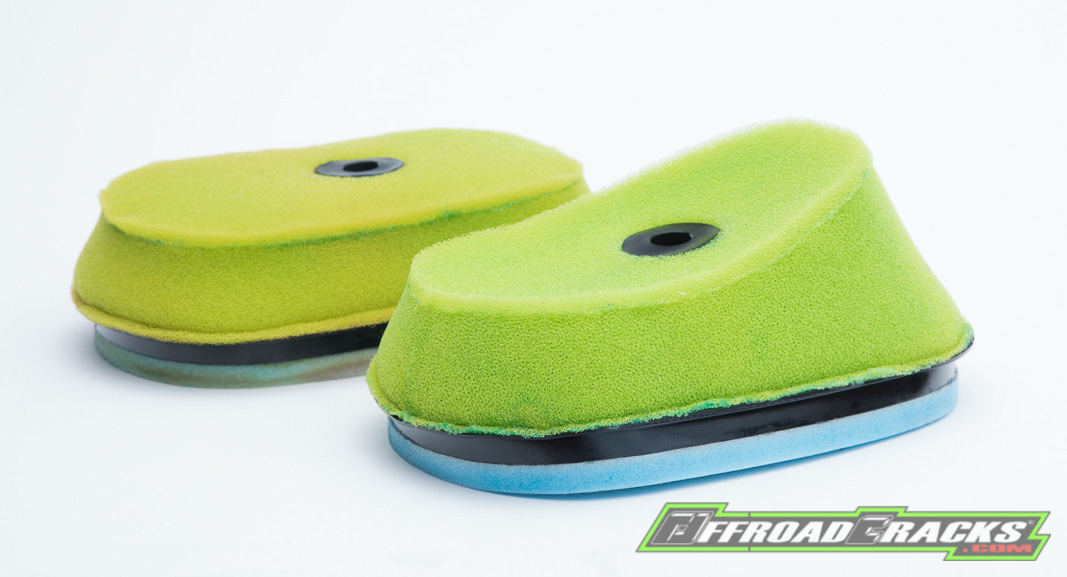
CHASSIS
- Rahmen und Schwinge stammen von der CRF 450R 2019 (7. Generation): 190 Gramm leichter, optimiertes Flexverhalten ohne Einschränkung von Quer- und Trosionssteifigkeit, erhöhte Längssteifigkeit um die Längsachse
- Verbesserte Fahrstabilität und präzisere Kurvenkontrolle
- Showa-Gabel und -Federbein mit optimierter Lowspeed-Dämpfung: Vorteilhaft beim Bremsen/Beschleunigen
- Neue Bremsbelagmischung an der Hinterradbremse
- Schwarze D.I.D-Leichtmetall-Felgen
- Dunlop Geomax MX3S Bereifung
- Fatbar-Renthal-Lenker
- Widerstandsfähige Inset-Graphics
- Aerodynamisch optimierter Vorderrad-Kotflügel zur optimierten Frischluftzufuhr direkt an die Kühler
- Startgewicht mit allen Flüssigkeiten: 108kg
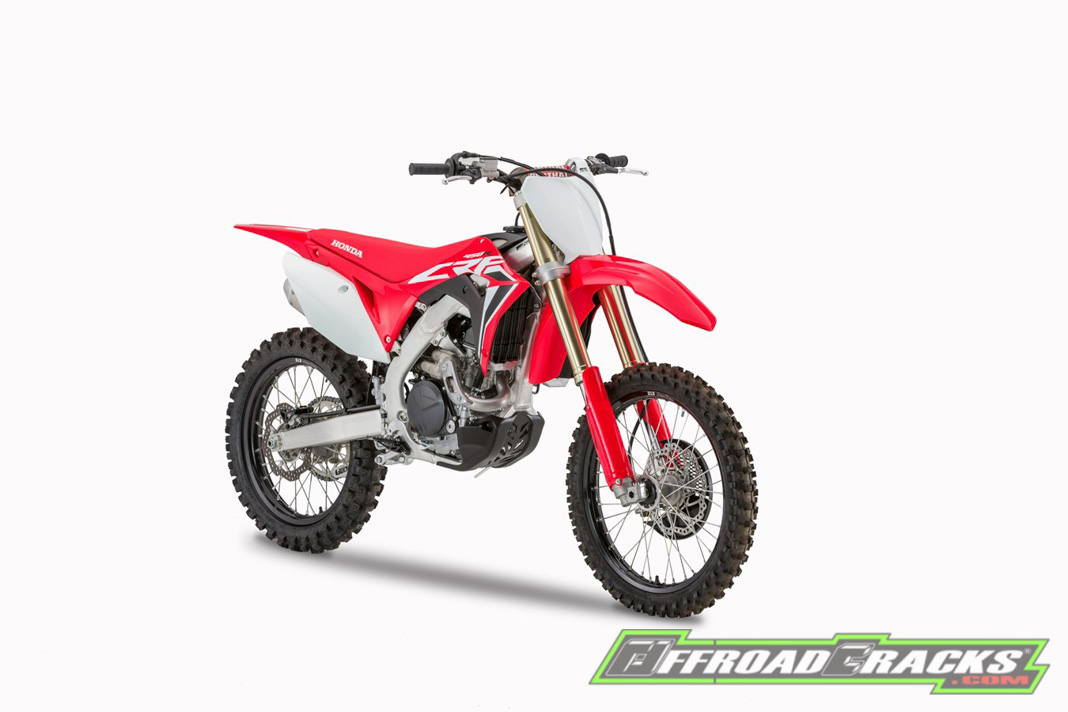
Die CRF 450R 2020 erhält als erstes Motocross-Bike die HSTC-Traktionskontrolle, ausgeschrieben Honda Selectable Torque Control. Das System arbeitet mit der HRC-Launch Control und den Mappings für die PGM-FI-Einstpitzung zusammen.
CRF 450 R 2020 – NEUERUNGEN
ELEKTRONIK
- HSTC-Traktionskontrolle zur Minimierung des Hinterradschlupfs und Steigerung der Traktion
- HSTC: 3 Fahrmodis wählbar – Modus 1 (geringfügiger Eingriff) – Modus 2 (mittelstarker Eingriff) – Modus 3 (starker Eingriff ohne Zeitverzug für schlammige Bedingungen)
- HSTC-Traktionskontrolle: Grüne LED-Anzeige, 0,5 Sekunden drücken, dann erfolgt der Modi-Wechsel bis hin zur Deaktivierung
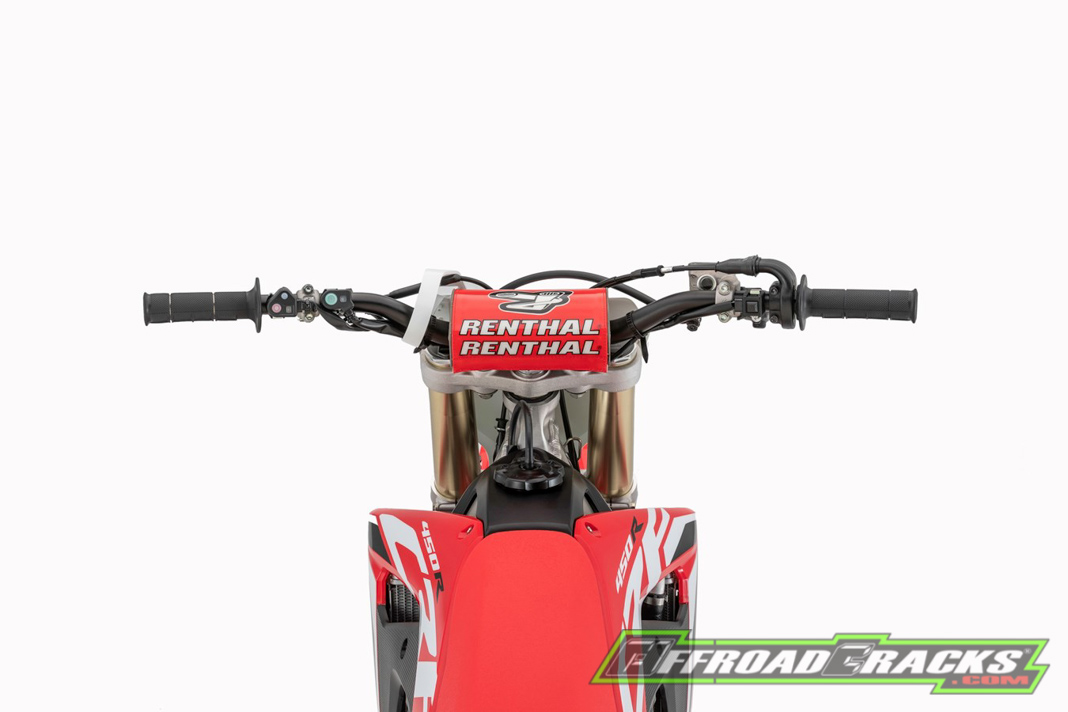
CHASSIS
- Showa-Gabel und -Federbein mit optimierter Lowspeed-Dämpfung: Vorteilhaft beim Bremsen/Beschleunigen
- Neue Bremsbelagmischung an der Hinterradbremse
- Tiefer positionierter Batteriehalter
- Schwarze D.I.D-Leichtmetall-Felgen
- Dunlop Geomax MX3S Bereifung
- Fatbar-Renthal-Lenker
- Widerstandsfähige Inset-Graphics
- Aerodynamisch optimierter Vorderrad-Kotflügel zur optimierten Frischluftzufuhr direkt an die Kühler
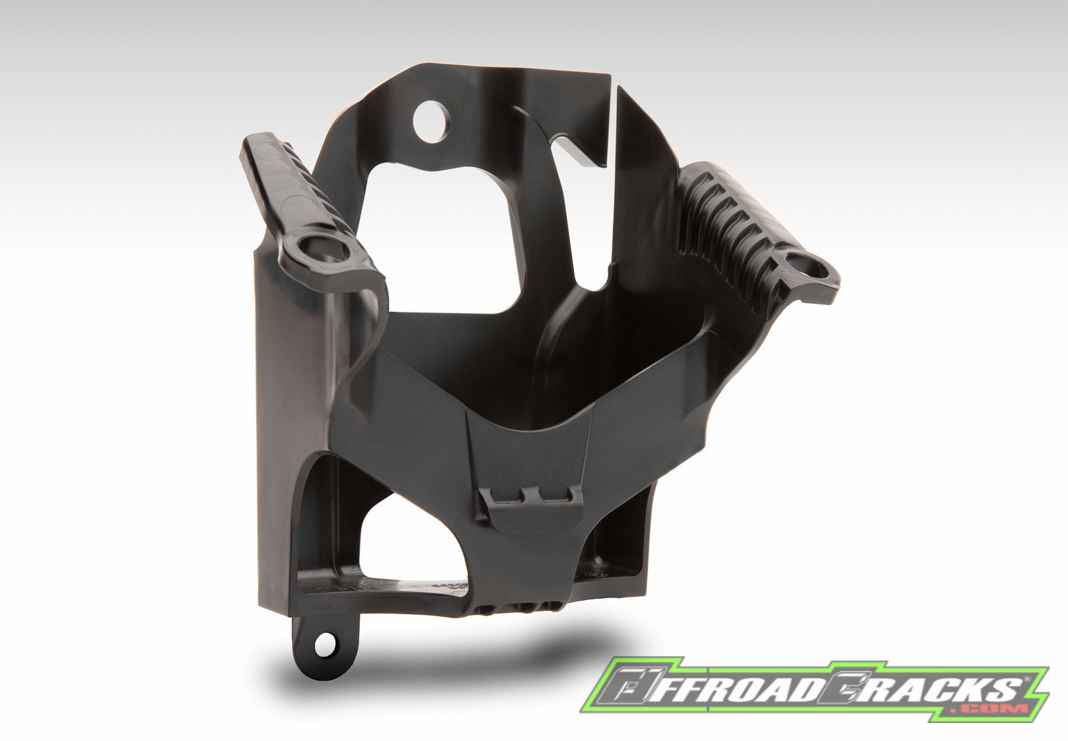
Preise und Lieferfähigkeit stehe bislang noch nicht fest, werden aber baldmöglichst nachgereicht.
Weitere Infos unter: www.honda.de/motorrad
Bilder: Honda
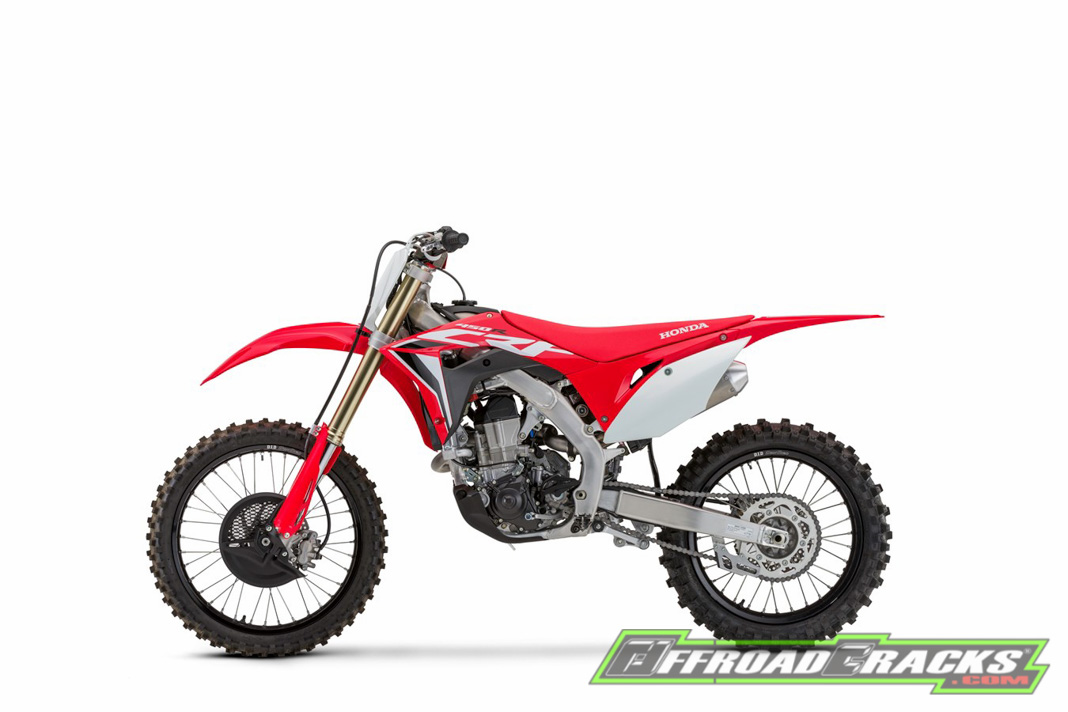
HONDA CRF450R 2020 – FIRST LOOK and Details
The Honda CRF450R has been the motocrosser to beat since its introduction 2002. It has become a byword for balance and agility, and as such has always offered its rider – whether amateur enthusiast or pro-racer – total control and the chance to get the very best from their ability. Plus, of course it’s built with the durability and longevity that Honda has long been famed for.
And of course it’s a machine that has constantly evolved, with every upgrade, large or small, drawing on lessons fed back from Honda’s racing programmes throughout the world.
In 17YM, under a total redesign headlined ‘ABSOLUTE HOLESHOT!’ Europe’s favourite open-class MX machine was effectively a ground-up redesign, wielding a major power boost from a brand-new engine, plus increased grip and drive from a completely redesigned chassis. Addition of standard-fit electric start in 18YM completed the package.
For 19YM, an HRC-developed cylinder head upped peak power and torque considerably, and HRC launch control was added along with revised rigidity balance for the frame and swingarm, a new front brake caliper and adjustable-position Renthal Fatbars.
But the MX pack waits for nobody, and the best machines have to get better; for 20YM the CRF450R gets a new electronics package to make it faster over a lap, yet with even more control.

Model Overview CRF450R 2020
Alongside optimised PGM-FI engine maps and HRC Launch Control, for 20YM the CRF450R gains a new Honda Selectable Torque Control (HSTC) system, with 3 riding Modes to assist every rider, from beginner to pro, to manage rear wheel traction and gain drive.
The CRF450R’s frame and swingarm are unchanged but there are new compression damping settings for the Showa suspension. The rear brake gets a pad material revised for durability, and the battery box is re-sited.
New graphics for the radiator shrouds complete the update.
3. Key Features CRF450R 2020
3.1 Electronics
* Honda Selectable Torque Control (HSTC) with 3 riding modes (plus OFF)
* HRC Launch Control offers 3 start options
* Engine Mode Select Button (EMSB) features 3 maps to adjust output character
The HSTC fitted to the 20YM CRF450R works to minimise rear wheel spin (thus wasted forward drive) and maximise traction. It doesn’t use a wheel speed sensor, and critically maintains feel at the throttle while managing power; ignition timing is retarded and the PGM-FI controlled when the rate of change of rpm is detected to have gone over a set amount.
The three Modes differ in drive management level for different riding conditions:
In Mode 1 the system intervenes most lightly, and after the longest time – useful for reducing wheelspin and maintaining control in tight corners.
Mode 3 has the system intervene more quickly and strongly, and is therefore useful in more slippery, muddy conditions.
Mode 2 naturally offers a mid-point between 1 and 3 in terms of speed and strength of intervention.
Pressing and holding the HSTC button for 0.5s will cycle the system to the next mode, with a green LED indication – 1 blink for mode 1, 2 for mode 2 and 3 for mode 3 – to confirm selection.
The HSTC system can also be switched off completely. When the engine is turned on, the system uses the last-selected setting.
HRC Launch Control gives any rider the best option for a strong start and also has 3 modes to choose from:
Level 3 – 8,250rpm, muddy conditions/novice.
Level 2 – 8,500rpm, dry conditions/standard.
Level 1 – 9,500rpm, dry conditions/expert.
Activating HRC Launch Control is easy – to turn on, pull in the clutch and push the Start button on the right. The purple LED will blink once for Level 1 selection. Push the Start button again, for 0.5s or longer, and the LED will blink twice for Level 2. Repeat the process and the LED will blink 3 times, indicating that Level 3 has been chosen.
The Engine Mode Select Button (EMSB) alters the engine’s characteristics and three maps are available to suit riding conditions or rider preference:
Mode 1 – Standard.
Mode 2 – Smooth.
Mode 3 – Aggressive.
The LED also displays mode selected, but with a blue light.
The rider controls and displays – Launch Control indicator, EFI warning, EMSB mode button, and LED indicator – are sited on the left handlebar, with a separate unit for the new HSTC alongside.
3.2 Chassis CRF450R 2020
* Showa fork and shock revised for increased low-speed compression damping under hard braking and acceleration
* Battery box re-sited to improve drive and airflow
* New rear brake pad material enhances power and longevity
The new CRF450R’s seventh-generation twin-spar aluminium frame was revised in detail for 19YM and is unchanged for 20YM; it maintains lateral and torsional stiffness for turning ability and traction, with increased yaw-angle stiffness for improved stability and tracking accuracy into, through and out of a corner.
The aluminium swingarm has a stiffer rigidity balance tuned to match the frame; the battery box is now sited 28.5mm lower to improve mass centralisation and drive. Rake and trail are set at 27.4°/116mm, with wheelbase of 1482mm; dry weight is 108kg, wet weight 112kg
Fully adjustable, the 49mm Showa USD coil spring fork is a version of the Showa ‘factory’ fork supplied to MX race teams in the Japanese championship. For 20YM – with the target of improved response in the hard-braking zone – the rod-end ‘B’ hole diameter has decreased from 2.4 to 1.6mm to increase the low-speed compression damping.
Likewise, the Showa rear shock’s main piston valving has been revised with greater low-speed compression damping (and less high-speed compression damping) to give improved control under hard acceleration.
The standard-fit, lightweight Renthal Fatbar flex for optimal comfort; the top yoke features two handlebar-holder locations for moving the handlebar rearward and forward by 26mm. When the holder is turned 180°, the handlebar can be moved an additional 10mm from the base position, resulting in four unique riding positions.
The twin-piston front brake caliper uses 30 and 27mm diameter pistons; along with low-expansion rate brake hose, it gives both a strong feel and improved staying power. It works on a 260mm wave-pattern disc. For 20YM a new rear brake pad material for the single-piston caliper increases power and durability in muddy conditions, and dispenses with the need of a cover guard for the 240mm wave-pattern disc.
Lightweight DID aluminium rims, with directly attached spoke pattern layout are finished in black; the front is a 21 x 1.6in, the rear a 19 x 2.15in. Fitted as standard equipment are Dunlop’s MX3SF and MX3S soft terrain tyres.
The CRF450R uses a lightweight 6.3L titanium fuel tank. The smooth external lines of the plastics help the rider move easily and the narrow frontal area and front mudguard directs an efficient funnel of air to the radiator. The radiator shrouds use durable film inset graphics – updated for 20YM – that cover a wide area with scratch-resistant style.
3.3 Engine CRF450R 2020
* Engine unchanged from 19YM HRC-led power and torque upgrade
* PGM-FI and HRC Launch Control mapping optimised
The 19YM boost in peak power and torque to the CRF450R’s 449.7 four-valve Unicam engine was significant – 1.8kW more power at 9,500rpm and 2Nm more torque at 7,500rpm – but not achieved at the expense of low-down performance from 3,000rpm-up, which was also improved.
And the work HRC performed on the cylinder head was extensive; combustion chamber squish was revised, as well as piston skirt profile, piston ring and conrod while both right and left engine cases were optimised for strength versus weight.
For 20YM the engine hardware is unchanged, with the focus of development on refinements and optimisation of the PGM-FI mapping, HRC Launch Control and addition of HSTC.
Bore and stroke is set at 96 x 62.1mm with compression ratio of 13.5:1. A gear position sensor allows the use of three specific ignition maps for 1st and 2nd, 3rdand 4th, and 5th and the PGM-FI injects fuel twice per cycle – the new air cleaner element base employed in 19YM more than doubled the surface area, with much greater flow as a result. The exhaust uses differing, larger diameter bores where it splits from the downpipe; 35mm right and 42mm diameter left and the left exhaust is also 89mm longer than the right.
Rock-solid reliability has always been a big factor in the CRF450R’s success and a 5-hole piston oil jet and dual 12mm drum scavenge pump manage lubrication.
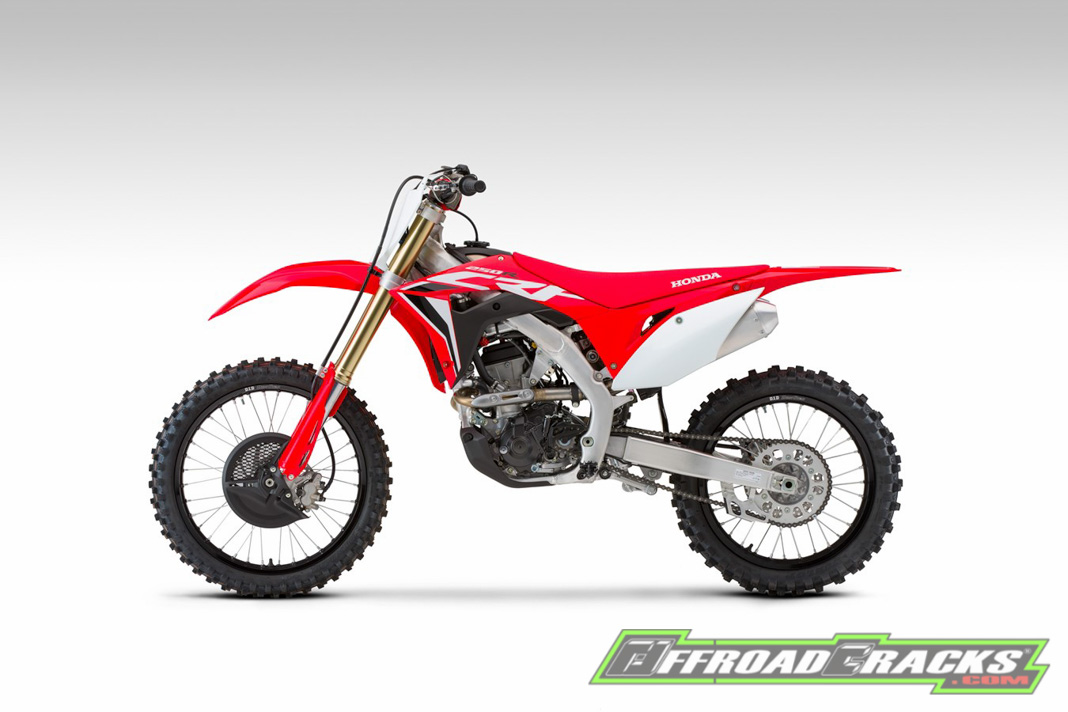
HONDA CRF250R 2020 – FIRST LOOK and DETAILS
The MX2 class is a relentless close-quarter battle – elbow-to-elbow action where every fraction of a second counts. Honda’s CRF250R has proved itself a worthy weapon for the fight. Competition has led its evolution over time, through increments and steps, into a platform that the amateur MX enthusiast – as well as pro-racer – can extract the utmost out of, every metre of every lap.
For 18YM the CRF250R underwent a ground-up redesign that inherited the ‘Absolute Holeshot’ philosophy of the 17YM CRF450R, sharing its seventh-generation frame, revised geometry and Showa suspension. It was also armed with a brand-new DOHC engine and switchable engine mapping; rider-focused ergonomics ensured it remained an MX machine that the hobby rider could exploit to their individual level of ability.
Just one year on from this full model change the 19YM CRF250R received a boost to low-rpm torque, through extensive intake and exhaust development, plus HRC launch control, revised front brake caliper and adjustable-position Renthal Fatbars.
Now 20YM is here. And the CRF250R moves forward once again. Low to mid-range torque receives a major boost, while its frame and swingarm are new, mirroring that of the 19YM CRF450R.
Model Overview
Riders love the CRF250R’s top-end power hit. After 19YM’s bottom-end improvement, focus of development for the 20YM machine was torque and power in the low-to-mid range. And Honda’s engineers have achieved just that – plus extra top end power – with extensive work to the combustion chamber.
The 2nd gear ratio is now closer to 3rd to reduce the natural drop in engine rpm when making that crucial upshift; clutch performance has also been improved. Detailed improvements to intake and exhaust efficiency, plus engine mapping all work together to achieve the overall goal of improved drive.
To match the engine upgrade the new CRF250R’s frame and swingarm are identical to the 19YM CRF450R. Both items are grams lighter but – more significantly – have a carefully tuned rigidity balance; combined with new compression damping settings for both front and rear Showa suspension, the result is improved stability, feel and accuracy while tracking through fast, bumpy turns.
Key Features – CRF250R 2020
Engine
* Much stronger torque through the mid-range, plus more peak power
* Revised cam profile and exhaust valve timing
* New combustion chamber shape reduces detonation
* Optimised ignition timing and individual FI mapping for gears
* 2nd gear ratio adjusted to maintain rpm when shifting to 3rd
Improved torque and power between 6-10,000rpm was the target for the 20YM CRF250R – and the dyno curves demonstrate the results clearly, with a significant gain in both compared to the previous model. Hand-in-hand with this boost went the reduction of performance-inhibiting engine ‘knock’ (detonation) at larger throttle openings/mid-rpm situations.
Peak power rises by 4%, and arrives at 12,000rpm; peak torque is up by a massive 8%, arriving at 10,000rpm. While peak power now arrives 1,000rpm earlier, the rev limit is reduced by just 100rpm to 14,300rpm, maintaining corner-to-corner over-rev.
Even more impressive is the significant upgrade to the all-important mid-range: torque at 8,000rpm is improved 10%, so the CRF250R now links its strong bottom-end torque and top-end power with a much harder, and consistent ‘hit’ right through the middle.
The improvements have been achieved through a new cam profile and revised shaping of the inlet/exhaust ports, piston and combustion chamber, which keep the exhaust valve open for longer, but with less overlap with the opening of the intake valve. The internal volume of the exhaust ports goes from 12cm3 to 12.7cm3, while the piston crown’s cutaways are re-shaped, increasing volume from 21.7cm3 to 22.2cm3. And to cope with the extra heat generated by the harder-working engine the radiator volume has been increased.
There are other detail changes; a 10% larger surface area for the air filter draws more air and the exhaust downpipe does away with the resonator mounted to the previous design. And to maintain engine rpm when shifting from 2nd to 3rd the gap between the two gears is closer; 2nd is now 16 main/28 counter giving a 1.75 ratio (from 15/27, 1.8) while 3rd remains 17/25 and 1.47.
To improve durability 3rd and 4th gear gain a new surface treatment; and, like the 19YM CRF450R, the addition of a gear position sensor allows the use of three specific ignition maps for 1st and 2nd, 3rd and 4th, and 5th. The clutch spring rate has also been increased, giving an 18% increase in performance.
Bore and stroke remains 79 x 50.9mm, with a 4.5mm cylinder offset to reduce friction and compression ratio of 13.9:1. The valves are titanium; 33mm inlet and 26mm exhaust. Lift is 10.5mm inlet and 9.5mm exhaust and the valve angle is set at 20.5°. The valve springs themselves are oval in section; the inlet valves are fed by symmetrical straight-shot downdraft intakes.
The piston is a Bridged Box design. Its rigidity converts combustion pressure into high output efficiency; a 5-hole piston oil jet maintains optimum piston cooling and ignition timing. A scavenge oil pump system reduces friction and ‘pumping’ losses at high rpm, by discharging oil and air in the crankcase and maintaining negative pressure. The oil also lubricates the clutch and gearbox, with a total oil capacity of 1.25L.
The combined oil pump/drive gear, oil filter and oil way are on the right side of the engine – the oil’s path around the engine is short and straightforward. Valve train lubrication is routed through the cylinder head to the inside of both inlet and exhaust cam, directly feeding the sliding surface of cam and rocker arm.
Electronics CRF250R 2020
* HRC Launch Control offers 3 start options
* Engine Mode Select Button (EMSB) features 3 maps to adjust output character
HRC’s Launch Control system gives any rider the best option for a strong start and has 3 modes to choose from:
Level 3 – 8,250rpm, muddy conditions/novice.
Level 2 – 8,500rpm, dry conditions/standard.
Level 1 – 9,500rpm, dry conditions/expert.
Activating HRC Launch Control is easy – to turn on, pull in the clutch and push the Start button on the right. The LED will blink once for Level 1 selection. Push the Start button again, for 0.5s or longer, and the LED will blink twice for Level 2. Repeat the process and the LED will blink 3 times, indicating that Level 3 has been chosen.
The Engine Mode Select Button (EMSB) alters the engine’s characteristics and three maps are available to suit riding conditions or rider preference: Mode 1 (Standard), Mode 2 (Smooth) and Mode 3 (Aggressive). The LED also displays Mode selected.
The rider controls and displays – engine stop button, EFI warning, EMSB mode button and LED indicator – are all sited on the left handlebar.
Chassis CRF250R 2020
* New frame and swingarm, taken directly from the 19YM CRF450R
* Improved stability and cornering accuracy
* Showa fork and shock re-valved for increased low-speed compression damping under hard braking and acceleration
* New rear brake pad material enhances power and longevity
The 20YM CRF250R gets the current CRF450R seventh-generation twin-spar aluminium frame, which was revised in detail for 19YM. Fractionally lighter (190g) due to a slimmer design around the swingarm pivot plates, it maintains lateral and torsional stiffness for turning ability and traction, while increasing yaw-angle stiffness for improved stability and tracking accuracy into, through and out of a corner.
The aluminium swingarm is also identical to the CRF450R’s, saving 160g and with a rigidity balance tuned to match the frame. Also lighter are the new footpegs, which use a 4-web (rather than 6) internal structure to clear mud; the battery box is now sited 28mm lower to improve mass centralisation.
Rake remains 27° 29’/116mm, with a slightly 4mm longer wheelbase of 1486mm. Wet weight is 108kg. The fully adjustable 49mm Showa USD coil spring fork is a version of the Showa ‘factory’ fork supplied to MX race teams in the Japanese championship; the cylinder has a 25mm diameter, the rod 14mm and the compression piston 39mm.
To complement the frame’s abilities – and with the target of improved response in the hard-braking zone – the rod-end ‘B’ hole diameter has decreased from 2.4 to 1.6mm to up the low-speed compression damping.
Likewise, the Showa rear shock’s main piston valving has been revised with greater low-speed compression damping (and less high-speed compression damping) to give improved control under hard acceleration.
The twin-piston front brake caliper uses 30 and 27mm diameter pistons; along with low-expansion rate brake hose, they give both a strong brake feel, and staying power. It works on a 260mm wave-pattern disc. For 20YM a new rear brake pad material for the single-piston caliper increases power and durability in muddy conditions, and dispenses with the need of a cover guard for the 240mm wave-pattern disc.
Lightweight DID aluminium rims, with directly attached spoke pattern layout are finished in black; the front is a 21 x 1.6in, the rear a 19 x 1.85in. Fitted as standard equipment are Dunlop’s GEOMAX MX3S tyres, 80/100-21 front and 100/90-19 rear.
Also standard-fit, the lightweight Renthal Fatbar flex for optimal comfort; the top yoke features two handlebar-holder locations for moving the handlebar rearward and forward by 26mm. When the holder is turned 180°, the handlebar can be moved an additional 10mm from the base position, resulting in four unique riding positions.
The CRF250R uses a lightweight 6.3L titanium fuel tank. Its smooth external lines of the plastics help the rider move easily, and the narrow frontal area and front mudguard directs an efficient funnel of air to the radiator. The radiator shrouds use durable film inset graphics that are identical to the 20YM CRF450R.
Quelle/Source: Honda Europe

